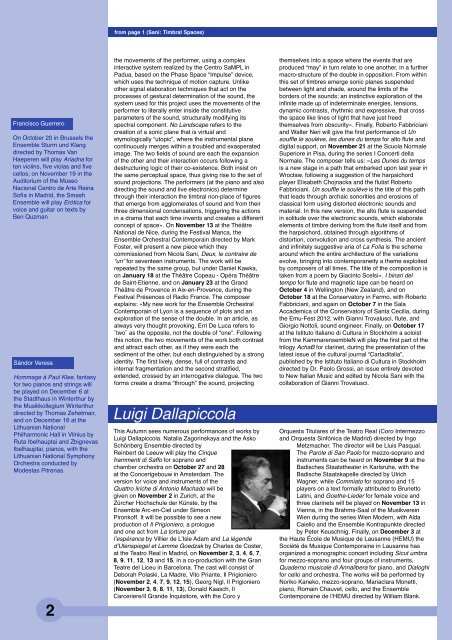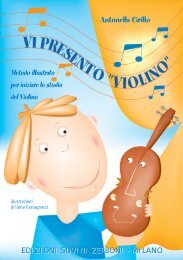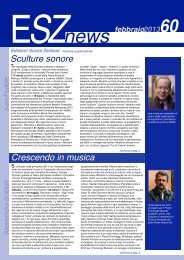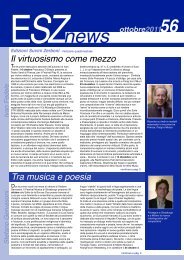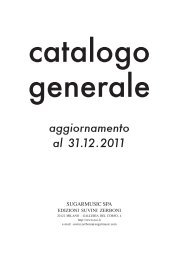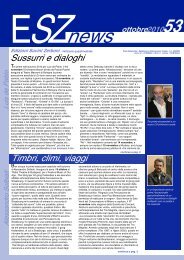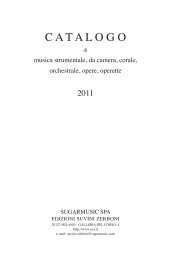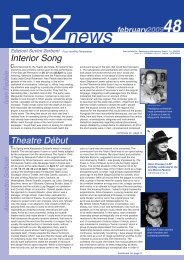Timbral Spaces Sound Labyrinths - Edizioni Suvini Zerboni
Timbral Spaces Sound Labyrinths - Edizioni Suvini Zerboni
Timbral Spaces Sound Labyrinths - Edizioni Suvini Zerboni
You also want an ePaper? Increase the reach of your titles
YUMPU automatically turns print PDFs into web optimized ePapers that Google loves.
Francisco Guerrero<br />
On October 20 in Brussels the<br />
Ensemble Sturm und Klang<br />
directed by Thomas Van<br />
Haeperen will play Ariadna for<br />
ten violins, five violas and five<br />
cellos; on November 19 in the<br />
Auditorium of the Museo<br />
Nacional Centro de Arte Reina<br />
Sofía in Madrid, the Smash<br />
Ensemble will play Erótica for<br />
voice and guitar on texts by<br />
Ben Quzman<br />
Sándor Veress<br />
Hommage à Paul Klee, fantasy<br />
for two pianos and strings will<br />
be played on December 6 at<br />
the Stadthaus in Winterthur by<br />
the Musikkollegium Winterthur<br />
directed by Thomas Zehetmair,<br />
and on December 16 at the<br />
Lithuanian National<br />
Philharmonic Hall in Vilnius by<br />
Ruta Ibelhauptai and Zbignevas<br />
Ibelhauptai, pianos, with the<br />
Lithuanian National Symphony<br />
Orchestra conducted by<br />
Modestas Pitrenas.<br />
2<br />
from page 1 (Sani: <strong>Timbral</strong> <strong>Spaces</strong>)<br />
the movements of the performer, using a complex<br />
interactive system realized by the Centro SaMPL in<br />
Padua, based on the Phase Space “Impulse” device,<br />
which uses the technique of motion capture. Unlike<br />
other signal elaboration techniques that act on the<br />
processes of gestural determination of the sound, the<br />
system used for this project uses the movements of the<br />
performer to literally enter inside the constitutive<br />
parameters of the sound, structurally modifying its<br />
spectral component. No Landscape refers to the<br />
creation of a sonic plane that is virtual and<br />
etymologically “utopic”, where the instrumental plane<br />
continuously merges within a troubled and exasperated<br />
image. The two fields of sound are each the expansion<br />
of the other and their interaction occurs following a<br />
destructuring logic of their co-existence. Both insist on<br />
the same perceptual space, thus giving rise to the set of<br />
sound projections. The performers (at the piano and also<br />
directing the sound and live electronics) determine<br />
through their interaction the timbral non-place of figures<br />
that emerge from agglomerates of sound and from their<br />
three dimensional condensations, triggering the actions<br />
in a drama that each time invents and creates a different<br />
concept of space». On November 13 at the Théâtre<br />
National de Nice, during the Festival Manca, the<br />
Ensemble Orchestral Contemporain directed by Mark<br />
Foster, will present a new piece which they<br />
commissioned from Nicola Sani, Deux, le contraire de<br />
“un” for seventeen instruments. The work will be<br />
repeated by the same group, but under Daniel Kawka,<br />
on January 18 at the Théâtre Copeau - Opéra Théâtre<br />
de Saint-Etienne, and on January 23 at the Grand<br />
Théâtre de Provence in Aix-en-Provence, during the<br />
Festival Présences of Radio France. The composer<br />
explains: «My new work for the Ensemble Orchestral<br />
Contemporain of Lyon is a sequence of plots and an<br />
exploration of the sense of the double. In an article, as<br />
always very thought provoking, Erri De Luca refers to<br />
˝two˝ as the opposite, not the double of “one”. Following<br />
this notion, the two movements of the work both contrast<br />
and attract each other, as if they were each the<br />
sediment of the other, but each distinguished by a strong<br />
identity. The first lively, dense, full of contrasts and<br />
internal fragmentation and the second stratified,<br />
extended, crossed by an interrogative dialogue. The two<br />
forms create a drama “through” the sound, projecting<br />
Luigi Dallapiccola<br />
This Autumn sees numerous performances of works by<br />
Luigi Dallapiccola. Natalia Zagorinskaya and the Asko<br />
Schönberg Ensemble directed by<br />
Reinbert de Leeuw will play the Cinque<br />
frammenti di Saffo for soprano and<br />
chamber orchestra on October 27 and 28<br />
at the Concertgebouw in Amsterdam. The<br />
version for voice and instruments of the<br />
Quattro liriche di Antonio Machado will be<br />
given on November 2 in Zurich, at the<br />
Zürcher Hochschule der Künste, by the<br />
Ensemble Arc-en-Ciel under Simeon<br />
Pironkoff. It will be possible to see a new<br />
production of Il Prigioniero, a prologue<br />
and one act from La torture par<br />
l’espérance by Villier de L’Isle Adam and La légende<br />
d’Ulenspiegel et Lamme Goedzak by Charles de Coster,<br />
at the Teatro Real in Madrid, on November 2, 3, 4, 6, 7,<br />
8, 9, 11, 12, 13 and 15, in a co-production with the Gran<br />
Teatre del Liceu in Barcelona. The cast will consist of<br />
Deborah Polaski, La Madre, Vito Priante, Il Prigioniero<br />
(November 2, 4, 7, 9, 12, 15), Georg Nigl, Il Prigioniero<br />
(November 3, 6, 8, 11, 13), Donald Kaasch, Il<br />
Carceriere/Il Grande Inquisitore, with the Coro y<br />
themselves into a space where the events that are<br />
produced “may” in turn relate to one another, in a further<br />
macro-structure of the double in opposition. From within<br />
this set of timbres emerge sonic planes suspended<br />
between light and shade, around the limits of the<br />
borders of the sounds; an instinctive exploration of the<br />
infinite made up of indeterminate energies, tensions,<br />
dynamic contrasts, rhythmic and expressive, that cross<br />
the space like lines of light that have just freed<br />
themselves from obscurity». Finally, Roberto Fabbriciani<br />
and Walter Neri will give the first performance of Un<br />
souffle le soulève, les dunes du temps for alto flute and<br />
digital support, on November 21 at the Scuola Normale<br />
Superiore in Pisa, during the series I Concerti della<br />
Normale. The composer tells us: «Les Dunes du temps<br />
is a new stage in a path that embarked upon last year in<br />
Wrocław, following a suggestion of the harpsichord<br />
player Elisabeth Chojnacka and the flutist Roberto<br />
Fabbriciani. Un souffle le soulève is the title of this path<br />
that leads through archaic sonorities and erosions of<br />
classical form using distorted electronic sounds and<br />
material. In this new version, the alto flute is suspended<br />
in solitude over the electronic sounds, which elaborate<br />
elements of timbre deriving from the flute itself and from<br />
the harpsichord, obtained through algorithms of<br />
distortion, convolution and cross synthesis. The ancient<br />
and infinitely suggestive aria of La Folia is the scheme<br />
around which the entire architecture of the variations<br />
evolve, bringing into contemporaneity a theme exploited<br />
by composers of all times. The title of the composition is<br />
taken from a poem by Giacinto Scelsi». I binari del<br />
tempo for flute and magnetic tape can be heard on<br />
October 4 in Wellington (New Zealand), and on<br />
October 18 at the Conservatory in Fermo, with Roberto<br />
Fabbriciani, and again on October 7 in the Sala<br />
Accademica of the Conservatory of Santa Cecilia, during<br />
the Emu-Fest 2012, with Gianni Trovalusci, flute, and<br />
Giorgio Nottoli, sound engineer. Finally, on October 17<br />
at the Istituto Italiano di Cultura in Stockholm a soloist<br />
from the KammarensembleN will play the first part of the<br />
trilogy AchaB for clarinet, during the presentation of the<br />
latest issue of the cultural journal “Cartaditalia”,<br />
published by the Istituto Italiano di Cultura in Stockholm<br />
directed by Dr. Paolo Grossi, an issue entirely devoted<br />
to New Italian Music and edited by Nicola Sani with the<br />
collaboration of Gianni Trovalusci.<br />
Orquesta Titulares of the Teatro Real (Coro Intermezzo<br />
and Orquesta Sinfónica de Madrid) directed by Ingo<br />
Metzmacher. The director will be Lluis Pasqual.<br />
The Parole di San Paolo for mezzo-soprano and<br />
instruments can be heard on November 9 at the<br />
Badisches Staatstheater in Karlsruhe, with the<br />
Badische Staatskapelle directed by Ulrich<br />
Wagner, while Commiato for soprano and 15<br />
players on a text formally attributed to Brunetto<br />
Latini, and Goethe-Lieder for female voice and<br />
three clarinets will be played on November 13 in<br />
Vienna, in the Brahms-Saal of the Musikverein<br />
Wien during the series Wien Modern, with Alda<br />
Caiello and the Ensemble Kontrapunkte directed<br />
by Peter Keuschnig. Finally, on December 3 at<br />
the Haute École de Musique de Lausanne (HEMU) the<br />
Société de Musique Contemporaine in Lausanne has<br />
organized a monographic concert including Sicut umbra<br />
for mezzo-soprano and four groups of instruments,<br />
Quaderno musicale di Annalibera for piano, and Dialoghi<br />
for cello and orchestra. The works will be performed by<br />
Noriko Kaneko, mezzo-soprano, Mariaclara Monetti,<br />
piano, Romain Chauvet, cello, and the Ensemble<br />
Contemporaine de l’HEMU directed by William Blank.


